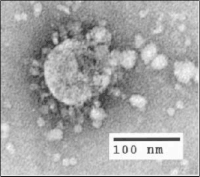
Photo from wikipedia
Significance The emergence of new human and animal coronaviruses demand novel strategies that characterize the threat potential of newly discovered zoonotic strains. We synthetically recovered recombinant wild-type and derivative swine… Click to show full abstract
Significance The emergence of new human and animal coronaviruses demand novel strategies that characterize the threat potential of newly discovered zoonotic strains. We synthetically recovered recombinant wild-type and derivative swine acute diarrhea syndrome coronaviruses (SADS-CoVs) that express indicator genes and characterized their growth, macromolecular biosynthesis, and replication efficiency in a variety of mammalian cell lines, including primary human cells. The data demonstrate that SADS-CoV has a broad host range and has inherent potential to disseminate between animal and human hosts, perhaps using swine as an intermediate species. Zoonotic coronaviruses represent an ongoing threat, yet the myriads of circulating animal viruses complicate the identification of higher-risk isolates that threaten human health. Swine acute diarrhea syndrome coronavirus (SADS-CoV) is a newly discovered, highly pathogenic virus that likely evolved from closely related HKU2 bat coronaviruses, circulating in Rhinolophus spp. bats in China and elsewhere. As coronaviruses cause severe economic losses in the pork industry and swine are key intermediate hosts of human disease outbreaks, we synthetically resurrected a recombinant virus (rSADS-CoV) as well as a derivative encoding tomato red fluorescent protein (tRFP) in place of ORF3. rSADS-CoV replicated efficiently in a variety of continuous animal and primate cell lines, including human liver and rectal carcinoma cell lines. Of concern, rSADS-CoV also replicated efficiently in several different primary human lung cell types, as well as primary human intestinal cells. rSADS-CoV did not use human coronavirus ACE-2, DPP4, or CD13 receptors for docking and entry. Contemporary human donor sera neutralized the group I human coronavirus NL63, but not rSADS-CoV, suggesting limited human group I coronavirus cross protective herd immunity. Importantly, remdesivir, a broad-spectrum nucleoside analog that is effective against other group 1 and 2 coronaviruses, efficiently blocked rSADS-CoV replication in vitro. rSADS-CoV demonstrated little, if any, replicative capacity in either immune-competent or immunodeficient mice, indicating a critical need for improved animal models. Efficient growth in primary human lung and intestinal cells implicate SADS-CoV as a potential higher-risk emerging coronavirus pathogen that could negatively impact the global economy and human health.
Journal Title: Proceedings of the National Academy of Sciences of the United States of America
Year Published: 2020
Link to full text (if available)
Share on Social Media: Sign Up to like & get
recommendations!